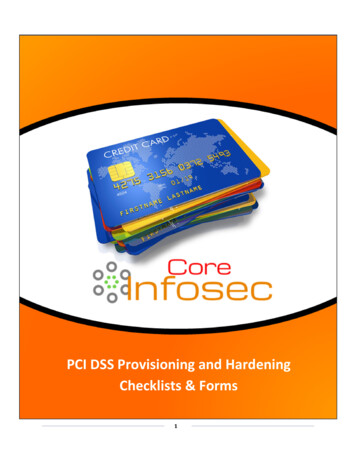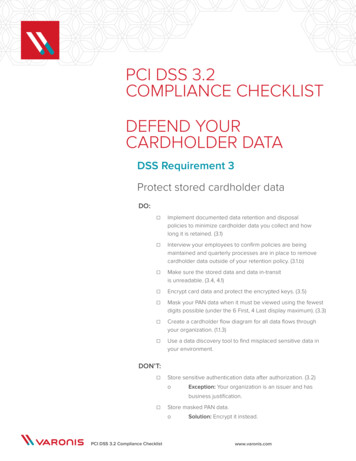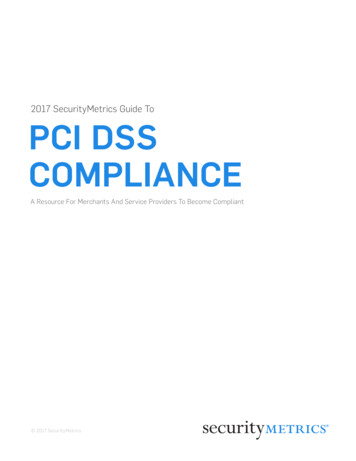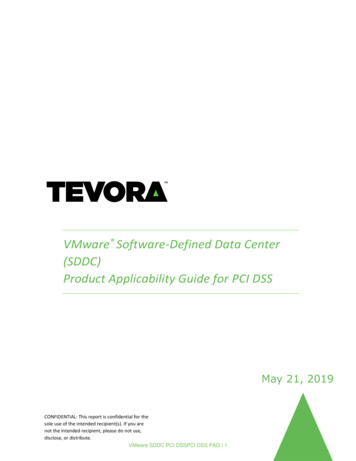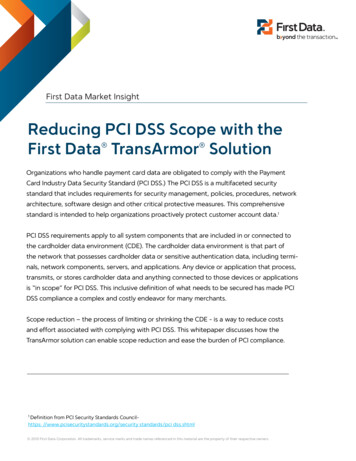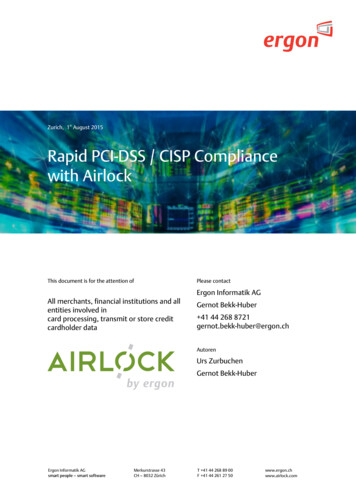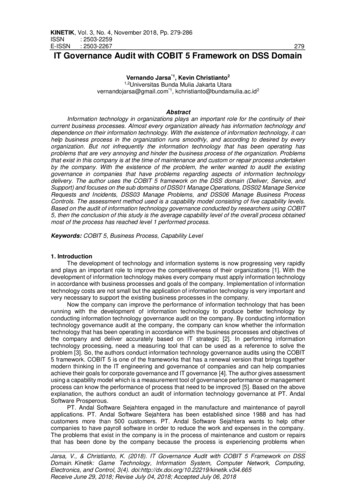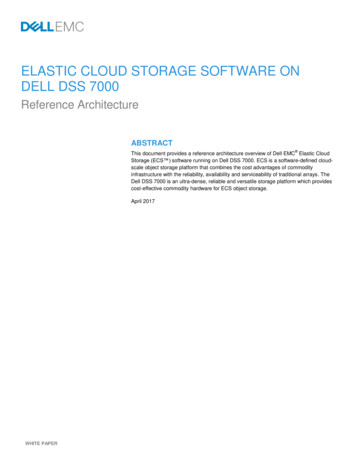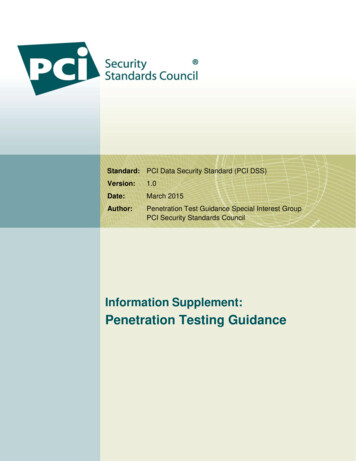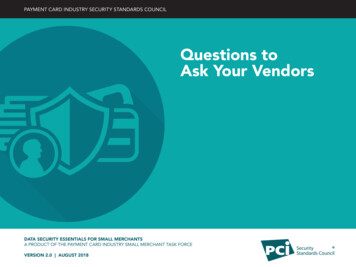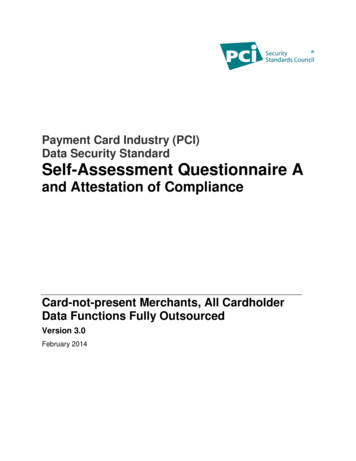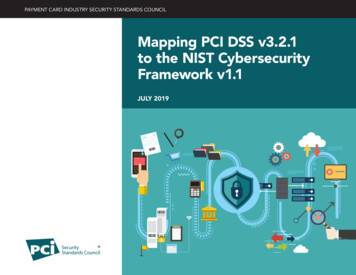
Transcription
PAYMENT CARD INDUSTRY SECURITY STANDARDS COUNCILMapping PCI DSS v3.2.1to the NIST CybersecurityFramework v1.1JULY 2019
Understanding the Mapping of PCI DSS to the NIST Cybersecurity FrameworkThe Payment Card Industry Data Security Standard (PCI DSS) and the National Institute of Standards and Technology’s (NIST) CybersecurityFramework (“the NIST Framework”) share the common goal of enhancing data security. This document, created by the PCI Security StandardsCouncil (PCI SSC), maps PCI DSS to the NIST Framework and provides a resource for stakeholders to use in understanding how to align securityefforts to meet objectives in both PCI DSS and the NIST Framework.PCI DSS is focused on the unique security threats and risks present in the payments industry. It defines security requirements for the protection ofpayment card data, as well as validation procedures and guidance to help organizations understand the intent of the requirements. PCI SSCworks with merchants, service providers, financial institutions, technology vendors, and others in the payments industry, as well as our assessorand forensic investigator communities. This keeps all stakeholders aware of current risks to payment data and ensures that PCI Standardscontinue to address those risks.The NIST Framework provides an overarching security and risk-management structure for voluntary use by U.S. critical infrastructure owners andoperators. The NIST Framework core components consists of security Functions, Categories, and Subcategories of actions. These Subcategoriesreference globally recognized standards for cybersecurity. As the NIST Framework is broadly focused on organizational risk management,achieving the outcomes stated therein does not provide assurance that payment data is also protected.Both PCI DSS and the NIST Framework are solid security approaches that address common security goals and principles as relevant to specificrisks. While the NIST Framework identifies general security outcomes and activities, PCI DSS provides specific direction and guidance on how tomeet security outcomes for payment environments. Because PCI DSS and the NIST Framework are intended for different audiences and uses,they are not interchangeable, and neither one is a replacement for the other.Mapping PCI DSS to the NIST FrameworkThis mapping is based on PCI DSS v3.2.1 and the Cybersecurity Framework v1.1, using the 2018-04-16 framework v.1.1 core” spreadsheet1.PCI SSC evaluated each NIST Framework outcome (for example, ID.AM-1) against PCI DSS requirements and identified the relevant PCI DSSrequirements for each outcome. The resultant mapping shows where the NIST Framework and PCI DSS contribute to the same securityoutcomes. PCI DSS requirements that map to an outcome are noted as “Informative References” in blue in the table below.The mapping covers all NIST Framework Functions and Categories, with PCI DSS requirements directly mapping to 96 of the 108 Subcategories.The mapping illustrates how meeting PCI DSS requirements may help entities demonstrate how NIST Framework outcomes are achieved forpayment frameworkMapping PCI DSS v3.2.1 to the NIST Cybersecurity Framework 2019 PCI Security Standards Council, LLC. All Rights ReservedJuly 2019Page 1
How to Use this Mapping DocumentStakeholders can use this mapping to identify opportunities for control efficiencies and greater alignment between organizational securityobjectives. For example, the mapping can help identify where the implementation of a particular security control can support both a PCI DSSrequirement and a NIST Framework outcome. Additionally, an entity’s internal evaluations to determine the effectiveness of implemented controlsmay help the entity prepare for either a PCI DSS or NIST Framework assessment, or both. In this way, the mapping supports a consistent andcoordinated approach to information security across an organization.The mapping is not a tool for demonstrating compliance to either PCI DSS or the NIST Framework, nor does meeting either a PCI DSSrequirement or its corresponding NIST Framework outcome result in the other being met.Mapping PCI DSS v3.2.1 to the NIST Cybersecurity Framework 2019 PCI Security Standards Council, LLC. All Rights ReservedJuly 2019Page 2
Mapping PCI DSS v3.2.1 to the NIST Cybersecurity Framework v1.1This table is copied directly from the NIST Cybersecurity "Framework V1.1 Core (Excel)"2 other than the PCI DSS references in blue. PCI SSC isnot responsible for the accuracy of the information from the NIST Framework, including the Informative References therefrom.CATEGORYSUBCATEGORYINFORMATIVE REFERENCES3ID.AM-1:Physical devices and systems withinthe organization are inventoried. CIS CSC 1 CIS CSC 2FUNCTION: IDENTIFY (ID)Asset Management (ID.AM):The data, personnel, devices,systems, and facilities that enablethe organization to achievebusiness purposes are identifiedand managed consistent with theirrelative importance toorganizational objectives and theorganization’s risk strategy.ID.AM-2:Software platforms and applicationswithin the organization areinventoried.23COBIT 5 BAI09.01, BAI09.02ISA 62443-2-1:2009 4.2.3.4ISA 62443-3-3:2013 SR 7.8ISO/IEC 27001:2013 A.8.1.1, A.8.1.2NIST SP 800-53 Rev. 4 CM-8, PM-5PCI DSS v3.2.1 2.4, 9.9, 11.1.1, 12.3.3COBIT 5 BAI09.01, BAI09.02, BAI09.05ISA 62443-2-1:2009 4.2.3.4ISA 62443-3-3:2013 SR 7.8ISO/IEC 27001:2013 A.8.1.1, A.8.1.2, A.12.5.1NIST SP 800-53 Rev. 4 CM-8, PM-5PCI DSS v3.2.1 2.4, kBlue text in this table has been added by PCI SSC and denotes PCI DSS v3.2.1 requirements that relate to NIST Cybersecurity Framework outcomes. Only the blue texthas been added. All other content in this table is copied directly from the NIST Cybersecurity "Framework V1.1 Core (Excel)" at this URL:https://www.nist.gov/cyberframework/framework. PCI SSC is not responsible for the accuracy of the information from the NIST Framework, including the InformativeReferences therefrom.Mapping PCI DSS v3.2.1 to the NIST Cybersecurity Framework 2019 PCI Security Standards Council, LLC. All Rights ReservedJuly 2019Page 3
CATEGORYSUBCATEGORYINFORMATIVE REFERENCES3ID.AM-3:Organizational communication anddata flows are mapped. CIS CSC 12 CIS CSC 12 CIS CSC 13, 14 CIS CSC 117, 19ID.AM-4:External information systems arecatalogued.ID.AM-5:Resources (e.g., hardware, devices,data, time, and software) areprioritized based on theirclassification, criticality, and businessvalue.ID.AM-6:Cybersecurity roles andresponsibilities for the entireworkforce and third-partystakeholders (e.g., suppliers,customers, partners) are established.3COBIT 5 DSS05.02ISA 62443-2-1:2009 4.2.3.4ISO/IEC 27001:2013 A.13.2.1NIST SP 800-53 Rev. 4 AC-4, CA-3, CA-9, PL-8, A.13.2.2PCI DSS v3.2.1 1.1.2, 1.1.3COBIT 5 APO02.02, APO10.04, DSS01.02ISO/IEC 27001:2013 A.11.2.6NIST SP 800-53 Rev. 4 AC-20, SA-9PCI DSS v3.2.1 1.1.1, 1.1.2, 1.1.3, 2.4COBIT 5 APO03.03, APO03.04, AP012.01, BA104.02, BAI09.02ISA 62443-2-1:2009 4.2.3.6ISO/IEC 27001:2013 A.8.2.1NIST SP 800-53 Rev. 4 CP-2, RA-2, SA-14, SC-6PCI DSS v3.2.1 9.6.1, 12.2COBIT 5 APO01.02, APO07.06, APO13.01, DSS06.03ISA 62443-2-1:2009 4.3.2.3.3ISO/IEC 27001:2013 A.6.1.1NIST SP 800-53 Rev. 4 CP-2, PS-7, PM-11PCI DSS v3.2.1 12.4, 12.5, 12.8, 12.9Blue text in this table has been added by PCI SSC and denotes PCI DSS v3.2.1 requirements that relate to NIST Cybersecurity Framework outcomes. Only the blue texthas been added. All other content in this table is copied directly from the NIST Cybersecurity "Framework V1.1 Core (Excel)" at this URL:https://www.nist.gov/cyberframework/framework. PCI SSC is not responsible for the accuracy of the information from the NIST Framework, including the InformativeReferences therefrom.Mapping PCI DSS v3.2.1 to the NIST Cybersecurity Framework 2019 PCI Security Standards Council, LLC. All Rights ReservedJuly 2019Page 4
CATEGORYBusiness Environment (ID.BE):The organization’s mission,objectives, stakeholders, andactivities are understood andprioritized; this information is usedto inform cybersecurity roles,responsibilities, and riskmanagement decisions.3SUBCATEGORYINFORMATIVE REFERENCES3ID.BE-1:The organization’s role in the supplychain is identified and communicated. COBIT 5 APO08.01, AP008.04, APO08.05, APO10.03, APO10.04,ID.BE-2:The organization’s place in criticalinfrastructure and its industry sector isidentified and communicated. COBIT 5 APO02.06, APO03.01 ISO/IEC 27001:2013 Clause 4.1 NIST SP 800-53 Rev. 4 PM-8ID.BE-3:Priorities for organizational mission,objectives, and activities areestablished and communicated. COBIT 5 APO02.01, APO02.06, APO03.01 ISA 62443-2-1:2009 4.2.2.1, 4.2.3.6 NIST SP 800-53 Rev. 4 PM-11, SA-14ID.BE-4:Dependencies and critical functionsfor delivery of critical services areestablished. COBIT 5 APO10.01, BAI04.02, BAI09.02 ISO/IEC 27001:2013 A.11.2.2, A.11.2.3, A.12.1.3 NIST SP 800-53 Rev. 4 CP-8, PE-9, PE-11, PM-8, SA-14ID.BE-5:Resilience requirements to supportdelivery of critical services areestablished for all operating states(e.g. under duress/attack, duringrecovery, normal operations). OBIT 5 BAI03.02, DSS04.02 ISO/IEC 27001:2013 A.11.1.4, A.17.1.1, A.17.1.2, A.17.2.1 NIST SP 800-53 Rev. 4 CP-2, CP-11, SA-13, SA-14APO10.05 ISO/IEC 27001:2013 A.15.1.1, A.15.1.12, A-15.1.3, A.15.2.1, A.15.2.2 NIST SP 800-53 Rev. 4 CP-2, SA-12Blue text in this table has been added by PCI SSC and denotes PCI DSS v3.2.1 requirements that relate to NIST Cybersecurity Framework outcomes. Only the blue texthas been added. All other content in this table is copied directly from the NIST Cybersecurity "Framework V1.1 Core (Excel)" at this URL:https://www.nist.gov/cyberframework/framework. PCI SSC is not responsible for the accuracy of the information from the NIST Framework, including the InformativeReferences therefrom.Mapping PCI DSS v3.2.1 to the NIST Cybersecurity Framework 2019 PCI Security Standards Council, LLC. All Rights ReservedJuly 2019Page 5
CATEGORYGovernance (ID.GV):The policies, procedures, andprocesses to manage and monitorthe organization’s regulatory,legal, risk, environmental, andoperational requirements areunderstood and inform themanagement of cybersecurity risk.SUBCATEGORYINFORMATIVE REFERENCES3ID.GV-1:Organizational cybersecurity policy isestablished and communicated. CIS CSC 19 CIS CSC 19 CIS CSC 19ID.GV-2:Cybersecurity roles andresponsibilities are coordinated andaligned with internal roles andexternal partners.ID.GV-3:Legal and regulatory requirementsregarding cybersecurity, includingprivacy and civil liberties obligations,are understood and managed.ID.GV-4:Governance and risk managementprocesses address cybersecurityrisks.COBIT 5 APO01.03, APO13.01, EDM01.01, EDM01.02ISA 62443-2-1:2009 4.3.2.6ISO/IEC 27001:2013 A.5.1.1NIST SP 800-53 Rev. 4 -1 controls from all familiesPCI DSS v3.2.1 1.5, 2.5, 3.7, 4.3, 5.4, 6.7, 7.3, 8.8, 9.10, 10.8, 11.6, 12.1COBIT 5 APO01.02, APO10.03, APO13.02, DSS05.04ISA 62443-2-1:2009 4.3.2.3.3ISO/IEC 27001:2013 A.6.1.1, A.7.2.1, A.15.1.1NIST SP 800-53 Rev. 4 PM-1, PM-2, PS-7PCI DSS v3.2.1 12.4, 12.5, 12.8, 12.9COBIT 5 BJI02.01, MEA03.01, MEA03.04ISA 62443-2-1:2009 4.4.3.7ISO/IEC 27001:2013 A.18.1.1, A.18.1.2, A.18.1.3, A.18.1.4, A.18.1.5NIST SP 800-53 Rev. 4 -1 controls from all security control familiesPCI DSS v3.2.1 3.1, 12.10 COBIT 5 EDM03.02, APO12.02, APO12.05, DSS04.02 ISA 62443-2-1:2009 4.2.3.1, 4.2.3.3, 4.2.3.8, 4.2.3.9, 4.2.3.11, 4.3.2.4.3,4.3.2.6.3 ISO/IEC 27001:2013 Clause 6 NIST SP 800-53 Rev. 4 SA-2, PM-3, PM-7, PM-9, PM-10, PM-11 PCI DSS v3.2.1 1.5, 2.5, 3.7, 4.3, 5.4, 6.7, 7.3, 8.8, 9.10, 10.8, 11.6, 12.1,12.23Blue text in this table has been added by PCI SSC and denotes PCI DSS v3.2.1 requirements that relate to NIST Cybersecurity Framework outcomes. Only the blue texthas been added. All other content in this table is copied directly from the NIST Cybersecurity "Framework V1.1 Core (Excel)" at this URL:https://www.nist.gov/cyberframework/framework. PCI SSC is not responsible for the accuracy of the information from the NIST Framework, including the InformativeReferences therefrom.Mapping PCI DSS v3.2.1 to the NIST Cybersecurity Framework 2019 PCI Security Standards Council, LLC. All Rights ReservedJuly 2019Page 6
CATEGORYRisk Assessment (ID.RA):The organization understands thecybersecurity risk toorganizational operations(including mission, functions,image, or reputation),organizational assets, andindividuals.SUBCATEGORYINFORMATIVE REFERENCES3ID.RA-1:Asset vulnerabilities are identified anddocumented. CIS CSC 4 COBIT 5 APO12.01, APO12.02, APO12.03, APO12.04, DSS05.01,DSS05.02 ISA 62443-2-1:2009 4.2.3, 4.2.3.7, 4.2.3.9, 4.2.3.12 ISO/IEC 27001:2013 A.12.6.1, A.18.2.3 NIST SP 800-53 Rev. 4 CA-2, CA-7, CA-8, RA-3, RA-5, SA-5, SA-11, SI-2,SI-4, SI-5 PCI DSS v3.2.1 6.1, 11.2, 11.3, 12.2ID.RA-2:Cyber threat intelligence andvulnerability information is receivedfrom information sharing forums andsources.ID.RA-3:Threats, both internal and external,are identified and documented.3 CIS CSC 4 CIS CSC 4COBIT 5 BAI08.01ISA 62443-2-1:2009 4.2.3, 4.2.3.9, 4.2.3.12ISO/IEC 27001:2013 A.6.1.4NIST SP 800-53 Rev. 4 PM-15, PM-16, SI-5PCI DSS v3.2.1 6.1COBIT 5 APO12.01, APO12.02, APO12.03, APO12.04ISA 62443-2-1:2009 4.2.3, 4.2.3.9, 4.2.3.12ISO/IEC 27001:2013 Clause 6.1.2NIST SP 800-53 Rev. 4 RA-3, SI-5, PM-12, PM-16PCI DSS v3.2.1 12.2Blue text in this table has been added by PCI SSC and denotes PCI DSS v3.2.1 requirements that relate to NIST Cybersecurity Framework outcomes. Only the blue texthas been added. All other content in this table is copied directly from the NIST Cybersecurity "Framework V1.1 Core (Excel)" at this URL:https://www.nist.gov/cyberframework/framework. PCI SSC is not responsible for the accuracy of the information from the NIST Framework, including the InformativeRefe
3 Blue text in this table has been added by PCI SSC and denotes PCI DSS v3.2.1 requirements that relate to NIST Cybersecurity Framework outcomes.Only the blue text has been added. All other content in this table is copied directly from the NIST Cybersecurity "Framework V1.1 Core (Excel)" at this URL:
